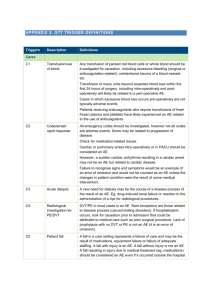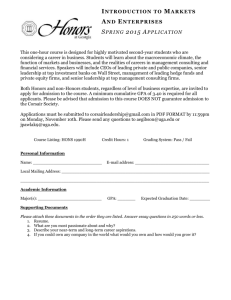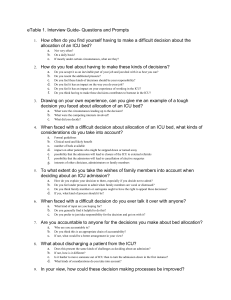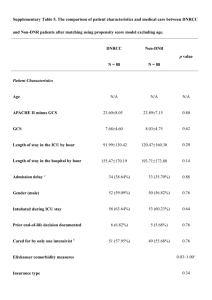GTT Trigger Definitions - Health Quality & Safety Commission
advertisement
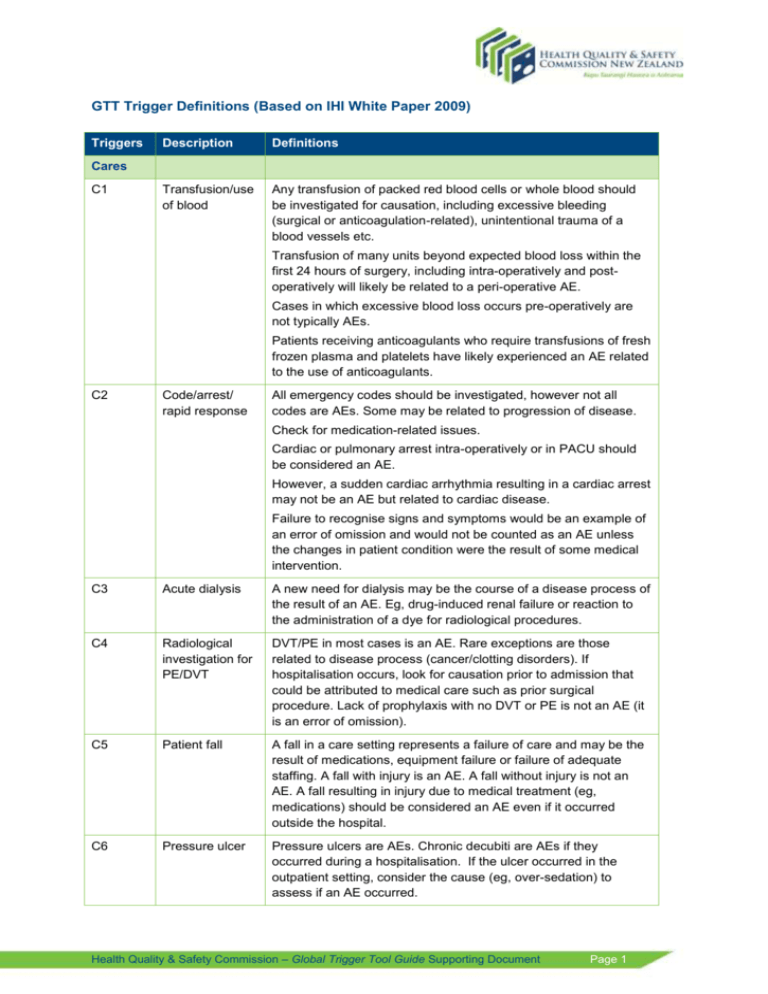
GTT Trigger Definitions (Based on IHI White Paper 2009) Triggers Description Definitions Transfusion/use of blood Any transfusion of packed red blood cells or whole blood should be investigated for causation, including excessive bleeding (surgical or anticoagulation-related), unintentional trauma of a blood vessels etc. Cares C1 Transfusion of many units beyond expected blood loss within the first 24 hours of surgery, including intra-operatively and postoperatively will likely be related to a peri-operative AE. Cases in which excessive blood loss occurs pre-operatively are not typically AEs. Patients receiving anticoagulants who require transfusions of fresh frozen plasma and platelets have likely experienced an AE related to the use of anticoagulants. C2 Code/arrest/ rapid response All emergency codes should be investigated, however not all codes are AEs. Some may be related to progression of disease. Check for medication-related issues. Cardiac or pulmonary arrest intra-operatively or in PACU should be considered an AE. However, a sudden cardiac arrhythmia resulting in a cardiac arrest may not be an AE but related to cardiac disease. Failure to recognise signs and symptoms would be an example of an error of omission and would not be counted as an AE unless the changes in patient condition were the result of some medical intervention. C3 Acute dialysis A new need for dialysis may be the course of a disease process of the result of an AE. Eg, drug-induced renal failure or reaction to the administration of a dye for radiological procedures. C4 Radiological investigation for PE/DVT DVT/PE in most cases is an AE. Rare exceptions are those related to disease process (cancer/clotting disorders). If hospitalisation occurs, look for causation prior to admission that could be attributed to medical care such as prior surgical procedure. Lack of prophylaxis with no DVT or PE is not an AE (it is an error of omission). C5 Patient fall A fall in a care setting represents a failure of care and may be the result of medications, equipment failure or failure of adequate staffing. A fall with injury is an AE. A fall without injury is not an AE. A fall resulting in injury due to medical treatment (eg, medications) should be considered an AE even if it occurred outside the hospital. C6 Pressure ulcer Pressure ulcers are AEs. Chronic decubiti are AEs if they occurred during a hospitalisation. If the ulcer occurred in the outpatient setting, consider the cause (eg, over-sedation) to assess if an AE occurred. Health Quality & Safety Commission – Global Trigger Tool Guide Supporting Document Page 1 Triggers Description Definitions C7 Re-admission within 30 days Any re-admission within 30 days of discharge could be an AE. Eg, surgical site infection, DVT, PE. C8 Restraint use Whenever restraints are used, review the documented reasons and evaluate the relationship between use of restraints and confusion from drugs etc (which would indicate an AE). C9 Healthcare associated infection Any infection after admission is likely an AE. Infections that cause admission to hospital should be reviewed to determine whether they are related to medical care (prior procedure, urinary catheter at home or in long-term care) versus naturally occurring disease (community acquired pneumonia). C10 In-hospital stroke Evaluate the cause of the stroke to determine whether it is associated with a procedure (eg, surgical, conversion of AF) or anticoagulation. When procedure or treatments have likely contributed to stroke this is an AE. C11 Transfer to higher level of care Review all transfers. As they are likely to be the result of an AE where patient’s condition deteriorated secondary to an AE. Eg, if admission due to respiratory arrest and intubation: this could be a natural progression of exacerbation of COPD (not AE) or due to PE post operatively (AE) or over-sedation of patient with COPD. Higher level of care may include telemetry, HDU, step down unit or if patient transferred from general medical or surgical nursing unit. C12 Any procedure/treat ment complication A complication resulting from any procedure is an AE. Procedure notes frequently do not indicate complications, especially if they occur hours or days after the procedure note has been dictated. Watch for complications noted in coding or discharge summary or other progress notes. C13 Early warning score (EWS) requiring response This includes EWS scores requiring medical review as well as an emergency response. Check the notes for reasons for medical review. C14 Decrease of greater than 25% in Hb or Hct Any decrease of 25 % or more in Hb Grams of Hct should be investigated – particularly if it occurred in a relatively short period of time (72 hours or less). Bleeding events are commonly identified by this trigger and may be related to use of anticoagulants or aspirin or a surgical misadventure. The decrease in Hb or Hct in itself is not an AE unless related to some medical treatment. A decrease associated with a disease proves is not an AE. C15 Positive blood culture A positive blood culture should be investigated as an indicator of an AE – specifically a hospital acquired infection. Generally AEs associated with this trigger include infections diagnosed 48 hours or more after admission: blood stream infections, sepsis from other device infections (catheter associated UTI) or any other hospital associated infection. Positive blood cultures related to other diseases (Community Acquired Pneumonia) would not be considered to be an AE). Health Quality & Safety Commission – Global Trigger Tool Guide Supporting Document Page 2 Triggers Description Definitions C16 Other Frequently when the record is reviewed, an AE is uncovered that does not fit a trigger. Any such event can be placed under this ‘other’ category. An event does not require a listed trigger to be counted as an event. M1 Vit K administration If Vit K used as a response to prolonged INR, review record for evidence of bleeding. An AE has likely occurred if there are laboratory reports indicating a drop in Hematocrit or guiac-positive stools. Check the progress notes for evidence of excessive bruising, GI bleed, hemorrhagic stroke, or large haematoma as examples of AEs. M2 Antihistamine use Antihistamine use is frequently associated with allergic reactions to drugs but can also be ordered as a sleep aid, pre-op/preprocedure medication or for seasonal allergies. Meds If the drug has been administered, check the record to determine if it was ordered for symptoms of an allergic reaction to a drug or blood transfusion administered either during the hospital stay or prior to admission – these are AEs. M3 Flumazenil use Flumazenil reverses the effect of benzodiazepine drugs. Determine why the drug was used. Examples of AEs are severe hypotension, or marked prolonged sedation. M4 Naloxone use Naloxone is a powerful narcotic antagonist. Usage likely represents an AE except in cases of drug abuse of self-inflicted overdose. M5 Anti-emetic use Nausea and vomiting commonly are the result of drug administration both in surgical and non-surgical settings. Anti-emetics are commonly administered. Nausea and vomiting that interferes with feeding, post-operative recovery or delayed discharge suggest an AE. One or two episodes treated successfully with anti-emetics would suggest no AE. Three episodes is considered an AE. M6 Oversedation/Hypote nsion Review the physician progress notes, nursing or multidisciplinary notes for evidence of over sedation and lethargy. Review vital signs records or graphics for episodes of hypotension related to the administration of a sedative analgesic or muscle relaxant. Intentional overdose is not considered an AE. M7 Abrupt medication stop Although the discontinuation of medications is a common finding in the record, abruptly stopping medications is a trigger requiring further investigation for cause. A sudden change in patient condition requiring adjustment of medications is often related to an AE. ‘Abrupt’ is best described as an unexpected stop or deviation from typical ordering practice. For example, discontinuation of an IV antibiotic for switch to oral is not unexpected. M8 Other Use this trigger for ADEs detected but not related to one of the medication triggers listed above. Health Quality & Safety Commission – Global Trigger Tool Guide Supporting Document Page 3 Triggers Description Definitions L1 C-difficile positive stool A positive C-difficile assay is an AE if a history of antibiotic use of present. L2 Partial thromboplastin time > 100 secs Elevated PTT measurements occur when patients are on heparin. Look for evidence of bleeding to determine if an AE has occurred. Elevated PTT in itself is not an AE – there must be manifestation such as bleeding, drop in Hg or Hct or bruising. L3 INR > 4 Look for evidence of bleeding to determine if an AE has occurred. An elevated INR in itself is not an AE. L4 Hypoglycaemia (< 3 mmol/L) Review for symptoms such as lethargy, shakiness documented in nursing notes and the administration of glucose, orange juice or other interventions. If symptoms are present, look for associate use of insulin or oral hypoglycaemics. If the patient is not symptomatic, there is no AE. L5 Raised Urea / Creatinine Review lab records for raised Urea/Creatinine. If a change of 2 x greater than baseline levels if found, review medication administration records for medications known to cause renal toxicity. Review physician progress notes and the Hx and physical for other causes of renal failure (such as pre-existing renal disease or diabetes) that could have put the patient at greater risk for renal failure. This would not be an AE but rather the progression of disease. Lab (> 2 x baseline) Surgical S1 Return to theatre A return to theatre can either be planned or unplanned and both can be a result of an AE. An example of an AE would be a patient who had internal bleeding following the first surgery and required a second surgery to explore for the cause and stop the bleeding. Even if the second surgery is exploratory but reveals no defect, this should be considered an AE. S2 Change in procedure When the procedure indicated in the post-operative notes is different from the procedure planned in the pre-operative notes or documented in the surgical consent, a reviewer should look for details as to why the change occurred. An unexpected change in procedure due to complications or device or equipment failure should be considered an AE, particularly if LOS increases or obvious injury has occurred. S3 Admission intensive care post-op Admission to ICU/HDU can be either a normal post-operative journey or it may be unexpected. The unexpected admissions frequently are related to operative AEs. For example, admission to intensive care following aortic aneurysm repair may be expected, but admission following knee replacement would be unusual. The reviewer needs to determine why the admission occurred. S4 Intubation/reintubation/BiPap in PACU Anaesthesia, sedatives or pain medications can result in respiratory depression requiring the use of BiPap or re-intubation post-operatively which would be an AE. Health Quality & Safety Commission – Global Trigger Tool Guide Supporting Document Page 4 Triggers Description Definitions S5 X-ray intra-op or in PACU Imaging of any kind that is not routine for the procedure requires investigation. An x-ray taken due to suspicion of retained items or incorrect instrument count or sponge count would be a positive trigger. The identification of a retained item necessitating an additional procedure is an AE. If the retained item is identified and removed without additional evidence of harm or re-operation, this is not considered an AE. S6 Intra-op or postop death All deaths that occur intra-operatively should be considered AEs unless death is clearly expected and the surgery was of a heroic nature. Post-operative deaths will require review of the record for specifics, but in general all post-op deaths will be AEs. S7 Mechanical ventilation > 24 hours post-op Short-term mechanical ventilation post-operatively for cardiac, major thoracic and certain abdominal procedures is planned. If the patient required mechanical ventilation beyond 24 hours, an intraoperative or post-operative AE should be considered. Patients with pre-existing pulmonary or muscular disease may experience more difficulty in quickly weaning from a ventilator post-operatively but this should not automatically exclude the possibility of an AE. Reviewers must use clinical judgment to determine whether the intra-operative and post-operative care was event-free or part of the disease process. S8 Intra-op: adrenalin/noradr enalin/naloxone/ flumazenil These medications are not routinely administered intraoperatively. Review anaesthesia and operative notes to determine the reasons for administration. Hypotension caused by bleeding or over-sedation are examples of AEs that might be treated with these medications. S9 Post-op troponin level greater than 1.5 ng/ml A postoperative increase in troponin levels may indicate a cardiac event. Reviewers will need to use clinical judgment as to whether a cardiac event has occurred. S10 Injury, repair or removal of organ Review operative notes and post-operative notes for evidence that the procedure included repair or removal of any organ. The removal or repair must be part of the planned procedure or this is an AE and likely the result of a surgical misadventure such as accidental injury. S11 Any operative complication This refers to any number of complications, including but not limited to PE, DVT, decubiti, MI renal failure etc. Pneumonia onset Any pneumonia diagnosed in ICU needs to be looked at carefully. If the evidence suggests pneumonia started prior to admission to the hospital, there is no AE, but if the review suggests initiation in the hospital, it is an AE. In general, any infection starting in not only the ICU but in any hospital unit will be considered nosocomial. Re-admissions either to the hospital or the ICU could represent a nosocomial infection from a previous hospital admission. ICU I1 Health Quality & Safety Commission – Global Trigger Tool Guide Supporting Document Page 5 Triggers Description Definitions I2 Re-admission ICU / HDU Admission to ICU/HDU can be either a normal post-operative journey or it may be unexpected. The unexpected admissions frequently are related to operative AEs. For example, admission to intensive care following aortic aneurysm repair may be expected, but admission following knee replacement would be unusual. The reviewer needs to determine why the admission occurred. I3 In-unit procedure Any procedure occurring on a patient in the ICU requires investigation. Look at all bedside procedures and the procedures done while the patient was in ICU. Complications will commonly not be on the dictated procedure note, but may be evidence by the care required which might indicate an event has occurred. I4 Intubation or Re-intubation Anaesthesia, sedatives or pain medications can result in respiratory depression requiring the use of BiPap or re-intubation post-operatively which would be an AE. E1 Re-admission to ED within 48 hours of discharge ED Look for drug reactions, infection or other reasons that events may have brought the patient back to the ED and then required admission. E2 Time in ED > 6 hours Long ED stay in some cases can represent less than optimal care. Look for complications arising from the ED such as falls, hypotension, or procedure related complications. ED Health Quality & Safety Commission – Global Trigger Tool Guide Supporting Document Page 6
